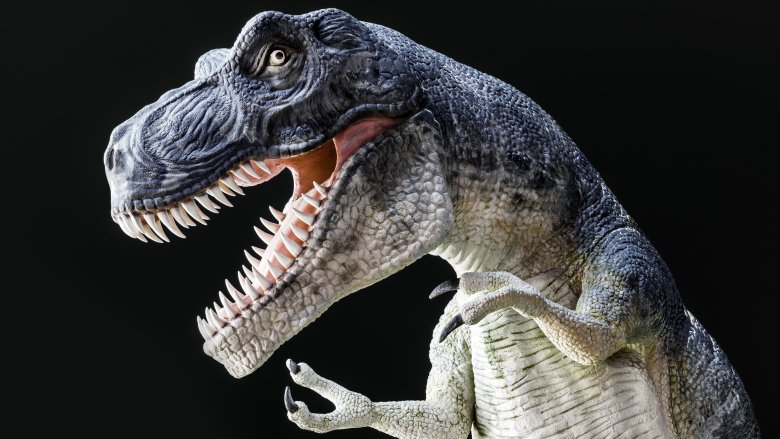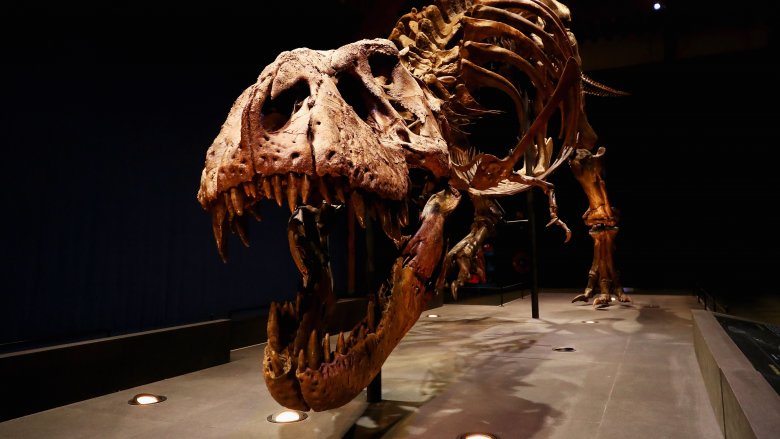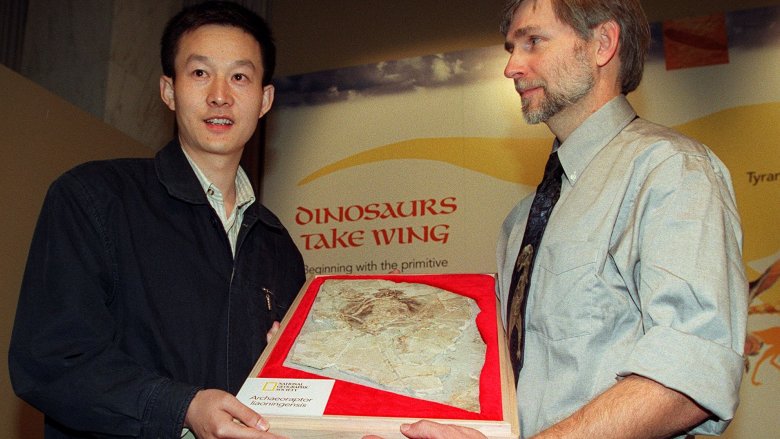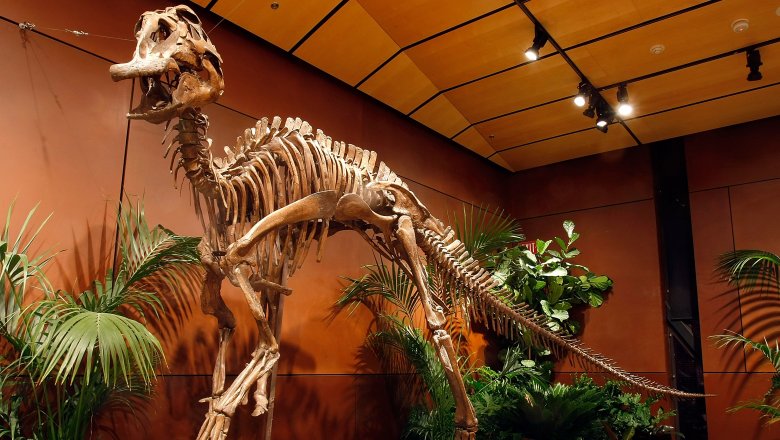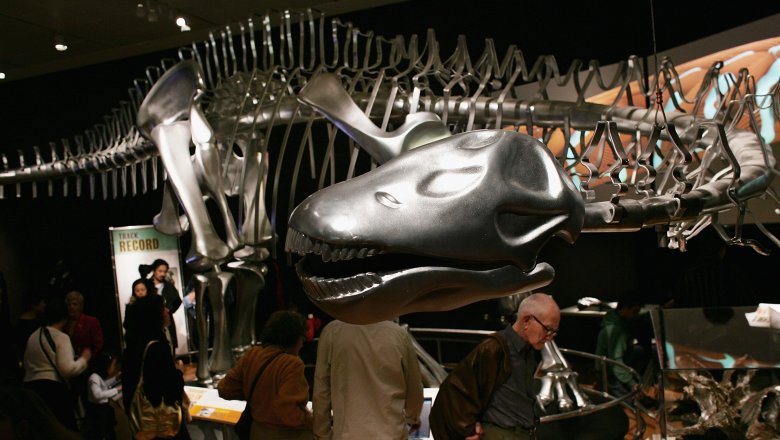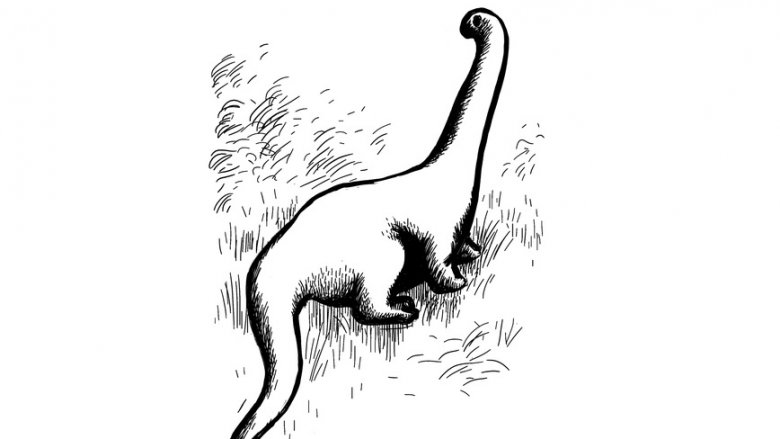Dinosaurs That May Never Have Actually Existed
Ever since we first started discovering dinosaurs in the mid-1800s, our thirst for uncovering as many of these ancient creatures as possible has proven unquenchable. The problem with this great dino hunt is that, since they lived dozens of mega-ennia ago, our perception of them is limited at best, and always changing. Remember, at one time we had no idea these gigantic, cold-blooded lizards were essentially birds, with feathers, warm blood, and adorable coos in place of blood-curdling roars. But that's not set in stone either — in 20 years, who knows what we'll "know" about T. rex and his fine feathered friends?
This uncertainty has produced many situations where archaeologists thought they had found themselves a previously unknown dinosaur only for others to discover years later there was actually nothing new behind the curtain. In a lot of cases, it was a simple case of a "new" fossil actually being a juvenile or elderly version of an already-discovered dino. But other stories, such as the following, are far more bizarre. Here are some dinosaurs we once thought existed, but now know to be faker than Jurassic Park.
Dynamosaurus imperiosus was T. rex before T. rex was cool
There are some amazing dinos out there, but no dinosaur is more famous and beloved than Tyrannosaurus rex, even though it would likely devour your flesh if you asked for an autograph. Unbelievably, if not for a couple mix-ups, we might've grown up calling the creature Dynamosaurus imperiosus, which sounds more like a member of GWAR than a dinosaur.
According to The Telegraph, in 1900 the assistant curator of the American Museum of Natural History, Barnum Brown, discovered what would eventually be called T. rex. He then gave it to museum paleontologist Henry Osborn for a closer inspection. But Osborn accidentally adding armor plating from a completely unrelated dino. He then called this armored giant Dynamosaurus imperiosus, not realizing he had turned two sets of dino bones into one, like a bonehead.
Two years later, the prolific Brown discovered yet another dinosaur, which won the name Tyrannosaurus rex. Several years later, however, Osborn realized he had bungled, and that both dinosaurs were actually the same. The armor-plated destroyer never existed, and this one meat-eater now had two names. Normally in cases like this, whichever name came first got to stay, so it would be Dynamosaurus imperiosus. But that didn't happen because the scientific journal describing the dinosaur called it Tyrannosaurus rex one page before calling it Dynamosaurus imperiosus. So technically the T. rex name was published first, meaning Dynamosaurus imperiosus was no more. Thank god, because T. rex is so much cooler to say than D. imp.
Archaeoraptor was more shoddily assembled than IKEA furniture
If millions of years of separation between us and dinosaurs doesn't make figuring them out confusing enough, sometimes mischievous humans make things even harder. Take the story of the archaeoraptor, which is just that: a mere story.
As Scientific American explains, in 1999 a brand-new dinosaur was supposedly discovered in Liaoning province, China. Dubbed Archaeoraptor liaoningensis, it supposedly had arms like a bird and a tail like a dinosaur, making it an unprecedented find. As National Geographic's senior assistant editor Christopher Sloan put it at the time, "this creature ... is a true missing link in the complex chain that connects dinosaurs to birds." Were we finally about to learn how these so-called "terrible lizards" could morph into cute little chirpers who live for seed?
Nope. Reality soon crashed the party, revealing that the "missing link" was a forgery, the result of poor Chinese farmers combining bones of entirely unrelated species together and selling the mess as a new dinosaur. This was enough for major scientific journals to refuse to publish a paper about Archaeoraptor (a prerequisite to officially naming a new discovery). Shortly thereafter, a professor named Xu Xing found an "Archaeoraptor" tail on another dinosaur at a Chinese institute, proving once and for all the dinosaur was literal fake news. If there's truly a missing link between dinos and birds, it's unfortunately just that: missing.
Amphicoelias fragillimus might be a big phony
At over 190 feet long, Amphicoelias fragillimus is by far the largest dinosaur ever discovered ... or it would be, except we can't find the bone that would prove it existed.
As FiveThirtyEight explains, in the late 1800s a nearly 5-foot dinosaur vertebra was unearthed in Cañon City, Colorado. It was then supposedly shipped to a Philadelphia paleontologist named Edward Drinker Cope, who wrote up a description of the vertebra and the dino once attached to it. In 1897, the bone (with Cope's other fossils) allegedly made its way to NYC's American Museum of Natural History, where it was cataloged and stored. But come 1921, when museum president Henry Osborn analyzed Cope's bone collection, he found no Amphicoelias fragillimus vertebra — just a brief description of something that isn't there.
But something must've been there for Cope (and later the Museum) to write about, right? No one knows for sure, but many people have theories. Some feel Cope simply made the animal up in a bid to one-up rival paleontologist Othniel Charles Marsh. Others say Cope mistyped the vertebra's size as 1,500 millimeters instead of the actual 1,050) and perhaps abandoned the fossil rather than be exposed and embarrassed. Still others feel the vertebra is both real and enormous, but it's simply ... somewhere. As the museum's head of paleontology, Mark Norell, explains, "We've got nearly a million specimens. ... Things just disappear. Sometimes they show up years later." Maybe someone should look under the couch.
Duck-billed hadrosaurs were about as real as Daffy Duck
Since dinosaurs are related to birds, and ducks are birds, the idea of duck-billed dinosaurs makes sense. Thus, ever since their discovery in the mid-1800s, hadrosaurs have been depicted with big ol' bills. The only problem is, they're not real. Duck-billed dinosaurs, as far as we can tell, simply didn't exist. What did exist, however, was somehow even weirder.
As explained by the Smithsonian, back when paleontologists first discovered the hadrosaur they were convinced it was an aquatic dinosaur that only ate soft plants. If they were big ducks, naturally they sported bills like ducks. But despite popular perception still being fixated on "duck," the world of paleontology abandoned that idea decades ago. Thanks to some very well-preserved skeletons, we now know the hadrosaur was a landlubber that ate far more than just soft plants. Its "bill" was actually a variety of beaks, and some pretty ridiculous ones at that.
The Edmontosaurus hadrosaur, for example, sported a beak that was square and nearly vertical, capable of grabbing far more than just leaves. Then there's the Tethyshadros insularis, whose beak was almost snowplow-shaped, with a serrated upper beak that was highest in the middle. No one knows why in the world such a beak existed. Paleontologist Darren Naish asked when summarizing the dino, "Did [they] help Tethyshadros to bite at specific food items? Were they for grooming? For display?" Everything made so much more sense when we could say, "No, they were just ducks."
Diplodocus lacustris lacks its own identity
Several species of long-necked diplodocus legitimately exist, but that doesn't mean all of them do. One variant, Diplodocus lacustris, enjoyed a 130-year run before, as described by NBC News, being exposed as a nothingburger of a dino just a few years ago.
Near Denver in 1884, naturalist Arthur Lakes discovered teeth from a new dinosaur nobody had seen before. He sent the teeth to paleontologist Charles Marsh, who decided they belonged to a diplodocus he dubbed "lacustris." Just like that, the world had a new dinosaur, until Marsh was proven wrong in 2013. (Not that he cared much, having long since died.)
Ten years before, near where Lakes had found Diplodocus lacustris, paleontologists found something extraordinary: the wonderfully preserved snout of an Apatosaurus ajax, which Morrison Natural History Museum director Matthew Mossbrucker lovingly named "Kevin." They couldn't safely dig Kevin out until 2011, and two years later they had their snout. Among the many things they discovered was that Kevin's teeth looked exactly like that of the Diplodocus lacustris. This meant Lakes' discovery wasn't a diplodocus of any kind — it was an Apatosaurus ajax, a creature discovered several years before Marsh found those teeth. Interestingly, A. ajax got its name from Charles Marsh, meaning he either didn't recognize the teeth a year later or he simply wanted credit for naming a new dino, even if it was imaginary. Kevin's a better name, anyway.
Mokele-mbembe: the 'living dinosaur' people won't stop believing in
Outside of birds, it's mostly common knowledge that dinosaurs are totally extinct. Note the word "mostly." There are actually people who believe dinosaurs are still out there, like the mokele-mbembe, which people are searching for to this day despite not a single shred of evidence that it actually exists.
As LiveScience reports, the mokele-mbembe supposedly lives in the Congo, where it feasts on crocodiles, hippos, and even elephants. It can do this because it's apparently 35 feet long, amphibious, and carnivorous. You'd think if such a creature actually existed somebody would've seen it by now, but that's obviously not the case. Mokele-mbembe is a myth based on literally nothing but talk — there are no photos, no videos, and no bones.
The only "evidence" is a tall tale dating back to 1909. A showman named Carl Hagenbeck wrote a book, called Beasts and Men, declaring that dinosaurs might still be alive in Africa. His evidence for such wild claims were that dinosaur bones exist. No, seriously. That's all he had, but people ran with it. Even reputable publications like the Washington Post declared "Brontosaurus Still Lives," which wasn't just sensationalism — it was inaccurate sensationalism.
The mokele-mbembe is a fun story, but nothing more ... probably. Until literally anyone shows any proof otherwise, this is nothing more than the Loch Ness monster minus the single photo true believers hang their hats on.
